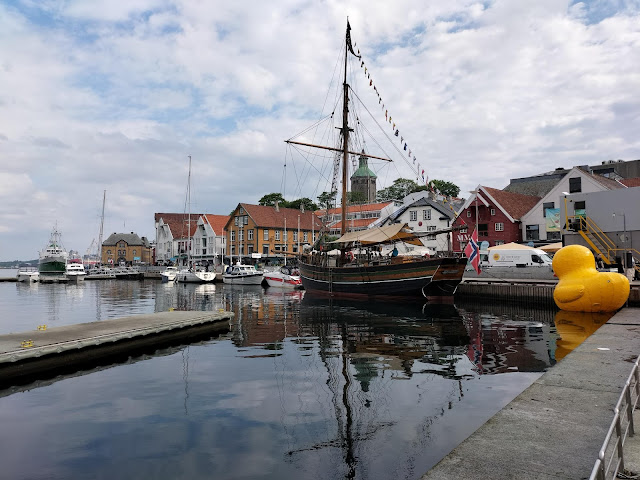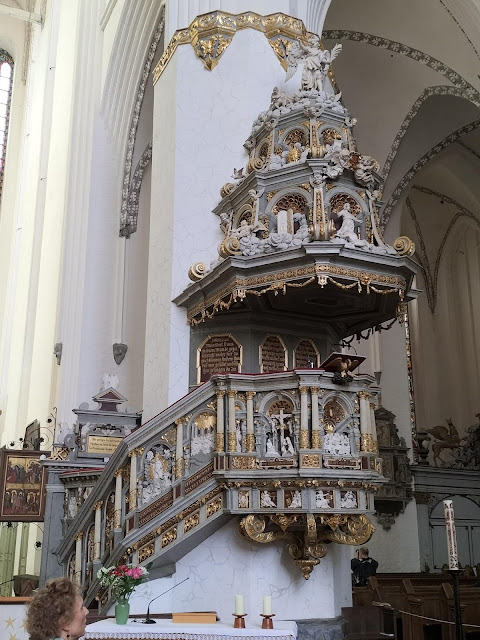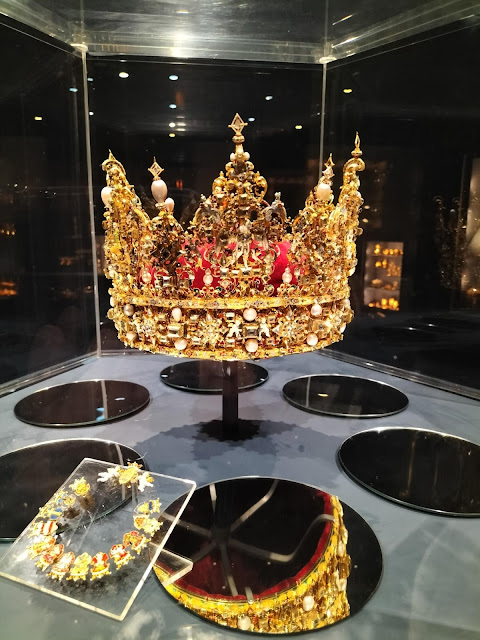We boarded the beautiful Celebrity Silhouette on Saturday 24 May and headed north. We enjoyed our first sea day, once again familiarising ourselves with the layout of the ship and attending two lectures, one by an astrophysicist on Skywatching and the other, a university professor who has lived all over the world, informed us about our next port, Stavanger in Norway.
We arrived there the following morning ready to take our first shore excursion. However, as we arrived at the meeting place, we were informed that due to the 4th and final stage of the Tour of Norway, an annual road bike race, being staged in the town, all the roads were closed, and our bus tour couldn't go ahead.
So, instead, we climbed up to the charming old town and then walked through the village, stopping to see the start of the race that had 100 entrants from all over Europe. In addition, there was a children's bike race which was highly entertaining. For some reason, one little girl had missed the start of the race and stood, pouting, next to her bike. Her longsuffering father put her on her bike, picked them up and raced off after the other participants!
Our next port of call was Skagen (pronounced Skein), Denmark's main fishing port. Our shore excursion took us first to the beautiful Renaissance moated Voergaard Castle whose history can be traced back to 1481.
One of the later owners, Ejnar Oberbech-Clausen, a Dane, had lived in France since 1906 and worked for Count Chenu-Lafitte. When the Count died, Oberbech-Clausen married the widow, Marie Henriette. The couple owned several chateaux in the Bordeaux region and Marie-Henriette, the daughter of a surgeon, owned an extensive art collection.
Marie-Henriette was unfortunately killed in an air raid during WW2 and Oberbech-Clausen decided to return to his native Denmark. He sold all the French chateaux and bought Voergaard Castle which he had renovated and brought 12 train cars of artworks back from France! So, the majority of furnishings are French, and extremely valuable. We took a tour through the castle and wandered down into the basement which is purportedly haunted...
We then drove to the town of Frederikshavn where we enjoyed coffee and a Kringle pastry at a local restaurant. From there we headed back towards Skagen and visited the Sand-covered Church, which was built 1355 and 1387. During the last half of the 18th Century the church was partially buried by sand from nearby dunes and each time a service was held the parishioners had to dig out the entrance. Finally, in 1795 the church was abandoned, and all but the tower was demolished. As you can see from the original photograph the church had been substantial. It's an eerie experience.
The German town of Warnemunde was our next port of call. We had visited the town on another cruise many years ago so this time we decided to spend the day in the nearby city of Rostock, which was established as early as 1218 and was once the largest and most important port for East Germany.
Once we navigated the ticket machine at the railway station, we boarded the comfortable suburban train for a 25-minute journey and then hopped on a tram at the Hauptbahnhof (main railway station) to the old town, which is impressive with its cobblestone streets and ancient buildings.
We first visited the impressive Gothic St Mary's Church which was built around 1230. Along with many fascinating inclusions, the church has an astronomical clock with medieval clockwork, from 1643, which is wound daily by hand. From there we wandered through the city and stopped for lunch at a cafe on the main street. In keeping with other European old towns, there are no cars on the streets, so it is easy to walk around. After a few hours (and 5kms later) we caught the tram and train back to Warnemunde. This time the town looked somehow different to when we had last seen it as we strolled along the canal lined with cafes and high-end shops before heading back to the ship.
The ship next docked on the island of Gotland in Sweden, and we enjoyed a few hours on a walking tour through its only town, Visby, a medieval city that dates back to 900AD. We viewed the town from the very top and then made our way down towards the sea, past the magnificent Santa Maria Cathedral. Between the 14th and 16th Centuries, Gotland was invaded and pillaged by the Danes and others with the result that many of their fourteen churches were destroyed or partly destroyed, but Santa Maria remained functional. We passed many ruins on our way to the Botanical Gardens where sections are still devoted to the growing of medicinal herbs as used in medieval times.
The next morning we arrived in Tallinn, Estonia and took the hop-on hop-off (HOHO) bus from the port for an hour's tour of the city before hopping off at the old city. The Alexander Nevsky Cathedral is just stunning inside but unfortunately photographs are not allowed, so Penny snuck one off the Internet...
We followed this up with a visit to the city's oldest cathedral from 1219, the Saint Mary the Virgin Cathedral, which has the most impressive collection of coats of arms. Coffee and cake were calling so we stopped at a lovely cafe that served Rombouts coffee. This brought back memories for Penny, who back in the 1980s at the family's Shaftesbury Tea Room, served Rombouts coffee in special cups and saucers.
We continued our walk down through the old town to Town Hall Square where we stopped for Caesar salads and a glass of wine/beer before hopping on the HOHO bus back to the ship.
Stockholm, Sweden is a beautiful city that stretches across 14 islands and is virtually sitting on water. On the sail-in, we passed by some of the almost 300,000 islands in an archipelago, many of which are inhabited. The city itself is modern with a lovely old town, typically European, and we lunched there at an Italian restaurant whilst watching the passing parade.
We had stayed in Stockholm for several days back in 2015 and on that occasion the Stockholm Marathon was being run. Coincidentally, it was on again this time we, with some 30,000 participants!
After three days of walking and adventure we were ready for a restful sea day. We attended a talk on Copenhagen, our next port of call and then drifted into the Craft Social bar so Penny could work on the blog. Fortuitously, the Gold Coast Suns were playing the Essendon Bombers live on the big screen and we were able to see a good win by the Suns! It helps that daylight here is night over there and we can occasionally see a footy game live - during the day.
The ship then docked at Copenhagen in Denmark, for two days. We bought tickets for the HOHO bus at the dock and then toured the city for 1.5 hours with interesting commentary. When we finally left the bus we discovered we were near, quite by accident, to the oldest pub in Copenhagen, where we had lunched nine years ago. So, we did it again.
The pub, called Hviids, has been operating since 1723. It serves a range of beers and traditional Danish open rye sandwiches called Smorrebrod with toppings that include meats, eggs, fish and terrines. They are delicious! The pub offers three sandwiches with a bottle of beer for A$19 (cheap by Danish standards), so we took two of those and Penny asked for a wine, to which the response was, 'which colour?', so she opted for white. No idea what it was, but it was great. We walked extensively through the streets of Copenhagen and then caught the HOHO bus back to the ship.
The next day we took the HOHO bus back into the city and toured the King's Gardens and Rosenborg Castle, which was built as a summer house in 1606 and then used as a royal residence. It eventually opened to the public in 1838 and is an incredibly ornate castle with a host of 17th Century furnishings.
When we left the castle, we walked to the Gammel Strand and took an hour-long canal boat trip, which gave us a fascinating look at the city from a different aspect. At the conclusion of the trip we somehow found our way back to Hviids and enjoyed a drink outside whilst we waited for the next HOHO bus.
On our last day on board, a sea day, we were fortunate to discover the Queensland/NSW State of Origin match about to start on TVs in the sports bar. So, we squeezed in and watched the entire game - which Queensland won by a large margin - with lots of other fans. A great result and a fitting end to a very enjoyable cruise!




















































































No comments:
Post a Comment